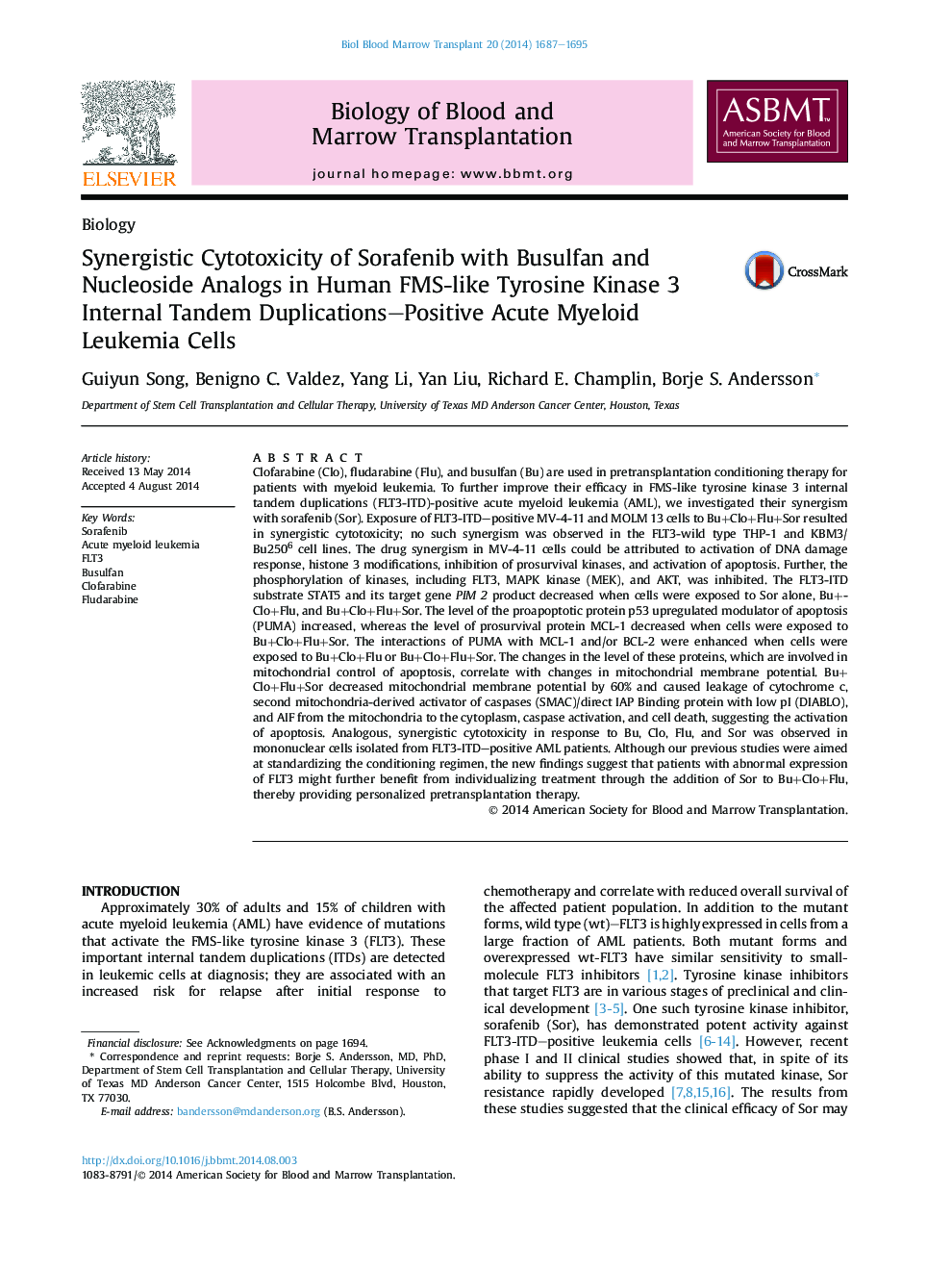| کد مقاله | کد نشریه | سال انتشار | مقاله انگلیسی | نسخه تمام متن |
|---|---|---|---|---|
| 2101970 | 1546274 | 2014 | 9 صفحه PDF | دانلود رایگان |

• Busulfan, clofarabine, fludarabine, and sorafenib are synergistic in FMS-like tyrosine kinase 3–mutated acute myeloid leukemia.
• The synergism is attributed to activation of DNA damage response and apoptosis.
• The level of histone 3 modifications increases and pro survival kinases are inhibited.
• No synergism was observed in wild type-FMS–like tyrosine kinase 3 acute myeloid leukemia cells.
• The findings justify this drug combination in pre–hematopoietic stem cell transplant conditioning for FMS-like tyrosine kinase 3–positive acute myeloid leukemia.
Clofarabine (Clo), fludarabine (Flu), and busulfan (Bu) are used in pretransplantation conditioning therapy for patients with myeloid leukemia. To further improve their efficacy in FMS-like tyrosine kinase 3 internal tandem duplications (FLT3-ITD)-positive acute myeloid leukemia (AML), we investigated their synergism with sorafenib (Sor). Exposure of FLT3-ITD–positive MV-4-11 and MOLM 13 cells to Bu+Clo+Flu+Sor resulted in synergistic cytotoxicity; no such synergism was observed in the FLT3-wild type THP-1 and KBM3/Bu2506 cell lines. The drug synergism in MV-4-11 cells could be attributed to activation of DNA damage response, histone 3 modifications, inhibition of prosurvival kinases, and activation of apoptosis. Further, the phosphorylation of kinases, including FLT3, MAPK kinase (MEK), and AKT, was inhibited. The FLT3-ITD substrate STAT5 and its target gene PIM 2 product decreased when cells were exposed to Sor alone, Bu+Clo+Flu, and Bu+Clo+Flu+Sor. The level of the proapoptotic protein p53 upregulated modulator of apoptosis (PUMA) increased, whereas the level of prosurvival protein MCL-1 decreased when cells were exposed to Bu+Clo+Flu+Sor. The interactions of PUMA with MCL-1 and/or BCL-2 were enhanced when cells were exposed to Bu+Clo+Flu or Bu+Clo+Flu+Sor. The changes in the level of these proteins, which are involved in mitochondrial control of apoptosis, correlate with changes in mitochondrial membrane potential. Bu+Clo+Flu+Sor decreased mitochondrial membrane potential by 60% and caused leakage of cytochrome c, second mitochondria-derived activator of caspases (SMAC)/direct IAP Binding protein with low pI (DIABLO), and AIF from the mitochondria to the cytoplasm, caspase activation, and cell death, suggesting the activation of apoptosis. Analogous, synergistic cytotoxicity in response to Bu, Clo, Flu, and Sor was observed in mononuclear cells isolated from FLT3-ITD–positive AML patients. Although our previous studies were aimed at standardizing the conditioning regimen, the new findings suggest that patients with abnormal expression of FLT3 might further benefit from individualizing treatment through the addition of Sor to Bu+Clo+Flu, thereby providing personalized pretransplantation therapy.
Graphical AbstractFigure optionsDownload high-quality image (130 K)Download as PowerPoint slide
Journal: - Volume 20, Issue 11, November 2014, Pages 1687–1695